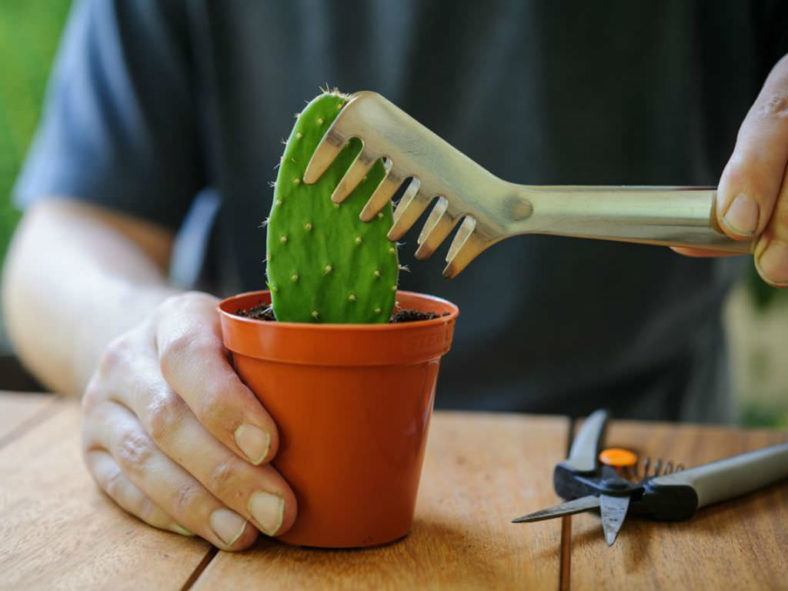Opuntia is a genus of cacti commonly known as Prickly Pear Cactus or Pear Cactus. They are easily identified by their upside-down pear-shaped pads or stem segments. Their fleshy pads produce large, showy flowers in the spring that turn into red, spiny fruits later in the season. There are more than 150 species of Opuntia. These drought-tolerant plants make low-maintenance houseplants that add Southwestern flair to a room's decor. Prickly Pear Cactus is easily propagated through stem cuttings.
1. Wear heavy work gloves to protect your hands from injury while working with a cactus. Take a cutting from a healthy, disease-free Prickly Pear Cactus. Harvest cuttings only when nighttime temperatures are a constant 60°F (16°C) or warmer. Choose a pad or oval segment without blemishes or scars. Grasp the top of the pad gently in one hand. Using a knife, cut the pad off the parent plant at the natural seam at its bottom.
2. Place the cutting on a flat surface in filtered sunlight. Choose a dry room with a constant temperature of 60°F (16°C) or higher. Leave the cutting for 7 to 10 days to allow callus tissue to form over the cut edge.
3. Mix one part perlite with one part compost to create a well-draining growing medium to plant the cactus. Fill a container with the mixture, leaving the top 1 to 2 inches (2.5 to 5 cm) empty. Use a container with drainage holes at the bottom.

4. Set the cactus cutting with the callused edge resting on the soil in the center of the pot. Push one-third to one-half of the cutting into the soil mixture. Tamp the soil down around the base of the cactus until the cutting can stand upright on its own.
5. Water the planted cutting using a watering can until the soil is evenly moist. Place the pot in a warm room, 60 °F (16 °C) or warmer, in filtered sunlight. Water the cactus when the top inch (2.5 cm) of soil begins to dry out.
6. Decrease supplemental watering to 0.25 inches (0.6 cm) of water applied every seven days once the cactus becomes established and produces new growth. Follow this water regimen when nighttime temperatures remain above 60°F (16°C). Give the cactus 0.25 inch (0.6 cm) of water every 14 days when nighttime temperatures drop below 60°F (16°C).
7. Once it begins producing new growth, move the cactus to full sunlight indoors to start acclimating it to brighter light. If you eventually plan to plant the cactus outdoors in the ground, move it to full sunlight outdoors after two weeks.
8. Grow the cactus in the container for at least one year. Transplant it in the spring once the soil temperature reaches 60°F (16°C). Plant the cactus in an area that receives full sunlight and contains well-draining soil. Dig a hole equal in depth and twice as wide as the plant's root ball. Place the root ball in the center of the hole. Backfill the hole with soil and tamp it down firmly. Water the cactus immediately after planting.
9. Water the planted cactus once weekly when nighttime temperatures are above 60°F (16°C). Water the cactus every 14 days when nighttime temperatures drop below 60°F (16°C).
Source: sfgate.com
Links
- Back to genus Opuntia
- Succupedia: Browse succulents by Scientific Name, Common Name, Genus, Family, USDA Hardiness Zone, Origin, or cacti by Genus